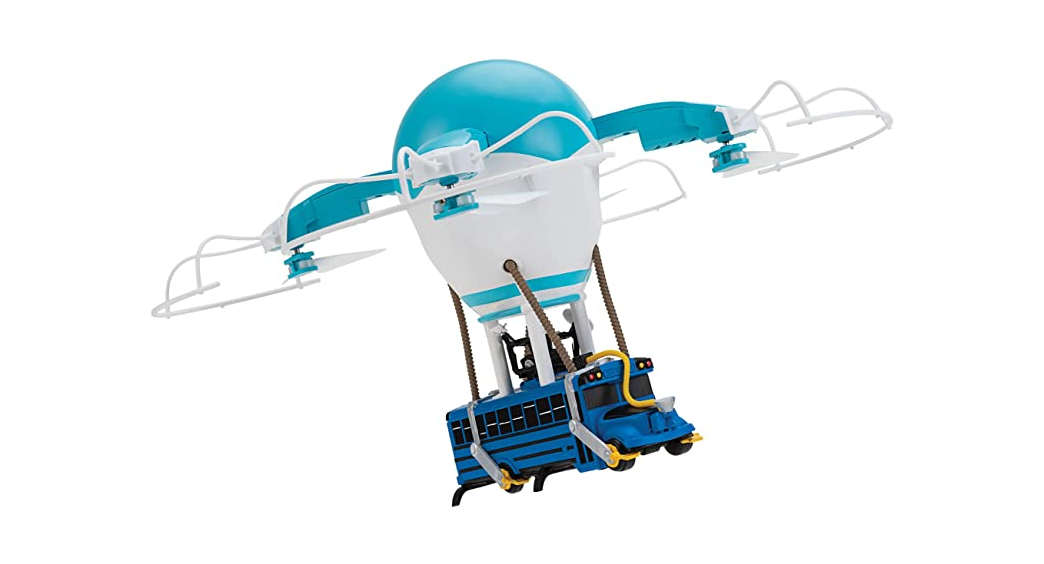 BATTLE BUS DRONEUSER GUIDECONTENTS:
BATTLE BUS DRONEUSER GUIDECONTENTS:
Warning: Always operate the toy away from the eyes or face.– A reminder that the toy shall be used with caution since skill is required in order to control the right and avoid collisions with the user, objects, or third parties;– Precautions to be observed such as “Do not touch the rotating rotor, avoid loose clothing or hair that could be caught in the rotor, do not fly near the face”;– Advise adult supervisors to teach children how to safely fly and control the toy;– Conditions to be observed when using the toy (e.g. flying room/area needed, indoors or outdoors, no obstacles, and persons within flying range to keep the toy in line of sight, maximum operating distance);
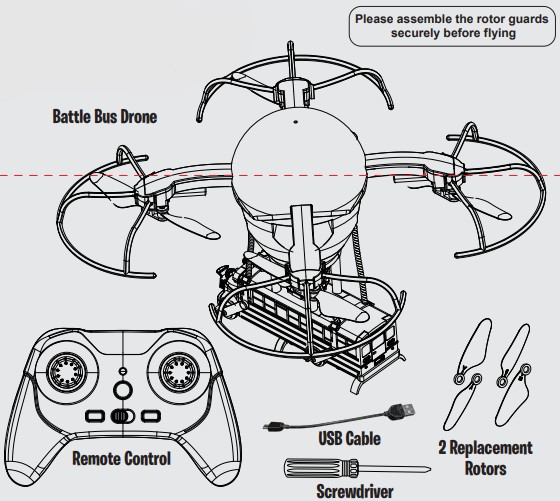
Warning & Precautions
Important Safety Instructions:– Read and follow all instructions.– Keep these instructions for future reference.– Heed all warnings.– Intended for children, age 8 and higher. Adult supervision is required.– Only use attachments/accessories specified by the manufacturer.– Before flying, always check the body, rotors, and battery for any damage or obstructions.– Battery should be free from cracks or swelling.– Keep the rotors clear of any obstructions and body parts to avoid potential damage and injury.– Manufacturer and dealer assume no liability for accidental damages from improper use or installation of parts, or from damage incurred from worn or broken parts.– Pilots are responsible for their actions and any damage caused by improper use.– Pilots should keep the craft in sight at all times during the flight. If you lose sight of the craft at any time, power down and cease flight immediately.– Only fly in large, open areas that are free from obstacles or potential hazards, such as trees, power lines, ceiling fans, and the like.– Flying over bodies of water is not recommended.– Flying at night is not recommended.– Never try to retrieve the craft from areas you cannot safely reach, such as rooftops or trees.– Never launch the craft from your hand.– Never leave the craft unattended while it is powered on or while the battery is charging.
Conforms to toy safety standards CPSIA, ASTM-F963, and EN-71
FCC ID: YNIJAZWARES119.
FCC Warnings:Warning: Changes or modifications to this unit not expressly approved by the party responsible for compliance could void the user’s authority to operate the equipment.This device complies with Part 15 of the FCC Rules. Operation is subject to the following two conditions:
- This device may not cause harmful interference, and
- this device must accept any interference received, including interference that may cause undesired operation.NOTE: This equipment has been tested and found to comply with the limits for a Class B digital device, pursuant to Part 15 of the FCC Rules. These limits are designed to provide reasonable protection against harmful interference in a residential installation. This equipment generates, uses, and can radiate radio frequency energy and, if not installed and used in accordance with the instructions, may cause harmful interference to radio communications. However, there is no guarantee that interference will not occur in a particular installation.If this equipment does cause harmful interference to radio or television reception, which can be determined by turning the equipment off and on, the user is encouraged to try to correct the interference by one or more of the following measures:
– Reorient or relocate the receiving antenna.– Increase the separation between the equipment and receiver.– Connect the equipment into an outlet on a circuit different from that to which the receiver is connected.– Consult the dealer or an experienced radio/TV technician for help.
Additional Warnings & Precautions:– WARNING: To reduce the risk of fire or electric shock, do not expose this apparatus to rain, moisture, dripping, or splashing.– CAUTION: Use of controls or adjustments or performance of procedures other than those specified may result in personal injury.– WARNING: Changes or modifications to this unit not expressly approved by the party responsible for compliance could void the user’s authority tooperate the equipment.– CAUTION: Danger of explosion if the battery is incorrectly replaced. Replace only with the same or equivalent type.– Lithium batteries, like all rechargeable batteries, are recyclable and should be recycled or disposed of according to state and local guidelines. Theyshould never be disposed of in normal household waste, and they should never be incinerated, as they might explode. Contact your local governmentfor disposal or recycling practices in your area. – WARNING: Shock hazard – Do Not Open.– Battery shall not be exposed to excessive heat such as sunshine or the like.– Keep new and used batteries away from children. If the battery compartment does not close securely, stop using the product and keep it away fromchildren.– If you think batteries might have been swallowed or placed inside any part of the body, seek immediate medical attention.– Do not mix old and new batteries.– Completely replace all old batteries with new ones.– Do not mix alkaline, standard (carbon-zinc), or rechargeable (ni-cad, ni-me, etc.) batteries.– Batteries should be recycled or disposed of as per state and local guidelines.
Features
Features– 6-axis gyroscope– LED flame light– Sound function– Control distance: 60-80 meters– Operating time: 5-6 minutes (on a full charge)– Charge time: approx. 120 minutes
Diagram and Specifications– Dimensions: 219 x 219 x 151 mm (LWH)– Weight: Approx. 106g
Includes– Battle bus drone– USB charging cable– 2.4 GHz remote control: requires 2 AAA batteries (Not Included)– 2 backup replacement rotors– 4 rotor guards– User’s manual– 1 screwdriver
Assembly
Rotor guardsAttach each rotor guard as shown. Place each rotor guard on the upside of the arm of the drone as shown and press firmly into place.

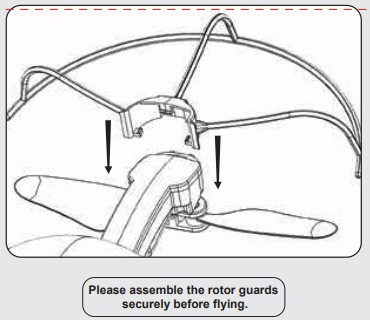
Remote Control
Functions

Battery Installation
- Batteries are to be replaced by an adult.
- Non-rechargeable batteries are not to be recharged.
- Rechargeable batteries are to be removed from the toy before being charged.
- Rechargeable batteries are only to be charged under adult supervision.
- For best performance, only the recommended batteries or their equivalent are to be used.
- Batteries must be inserted with the correct polarity.
- Do not mix new and used batteries.
- Do not mix different types of batteries.
- Exhausted batteries are to be removed from the toy.
- The supply terminals are not to be short-circuited
Step 1Push-button and slide down the battery cover

Step 2Install
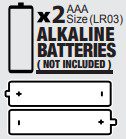
Place back cover before use.

Charging the Battery
Information and ProcedureThe drone’s battery must be charged before it can be flown. To avoid the risk of injury or damage, be sure the drone and remote control are both powered OFF.The charging time is approximately 120 minutes. Charge fully before use for best performance.Connect the USB charging cable (included) to the USB port of a powered ON computer or USB power adapter (not included), then connect the charging plug to the battery plug.While charging, the LED flame will display a blue light.When charging is complete, the light will turn OFF.

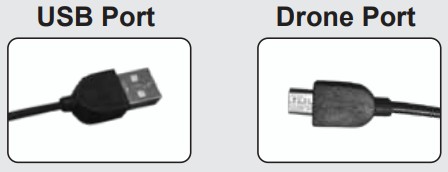
Be sure to correctly match the plug to the charging port or damage may occur.REMINDER: Do not charge overnight.Do not leave unattended while charging.
Flying
Remote Link & CalibrationBefore flying, the craft and the remote must be linked together and the gyroscopes on the craft must be allowed to calibrate.
Step 1Power ON the drone and place it on a flat surface. This is necessary for the drone’s gyroscopes to align properly. The lights on the craft will blink as it searches for a signal from the remote.Be sure you and the drone are facing the same forward direction, this will help with orientation while flying.

Step 2Power ON the remote. The light on the remote will blink and you will hear a double beeping sound.
Step 3Push the Left Control Stick (throttle) fully forward, wait for a chime to sound, then pull the stick fully rearward, and wait for a second chime. When this last chime has sounded, the craft is ready to fly.
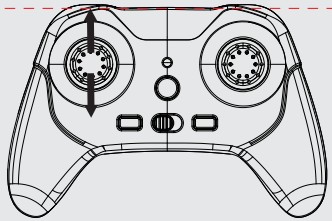
Step 4Pull down and inwards on both control sticks for 2-3 seconds. When the LED lights have stopped blinking and turn solid, the recalibration is complete and the drone is ready to fly.

Flight Controls
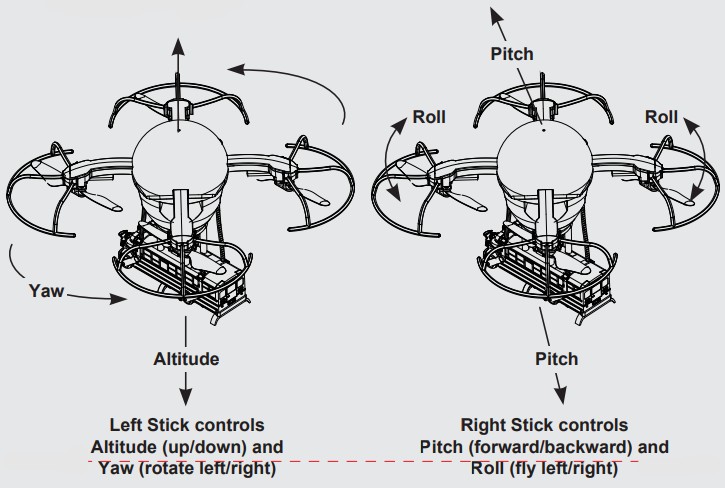
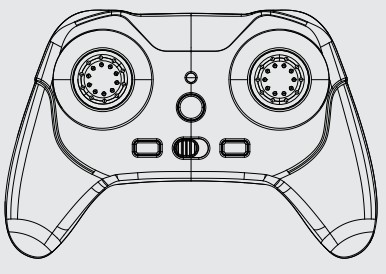
When You’re Finished FlyingTo land the drone, keep the Left Control Stick (throttle) in the lowest position and wait for the rotors to stop spinning. Power OFF the remote BEFORE powering OFF the drone.This will ensure that no signals are accidentally sent by the remote, reducing the chance of injury. After this is done, it is safe to pick up and power OFF the drone.
Trim Adjustment & Countering DriftEven after a craft is calibrated, it may still drift while airborne. To counter this effect, you can adjust the trim for better control. However, adjusting the trim may not entirely eliminate drifting. Air currents and other factors can still affect the craft’s handling.
Making Trim Adjustments Press the Trim button to enter Trimming Mode, indicated by a blinking indicator light on the remote. While in Trimming Mode, move the Right Control Stick ONCE in the opposite direction of the drift.
For example, if the drone is drifting forward, enter Trimming Mode and pull rearward on the stick to correct. If the craft is drifting right, pull left. The remote will chime once for each adjustment. It may take multiple adjustments to set the trim to your liking.
When you are finished, press the Trim button to exit Trimming Mode. You can also wait 3 seconds and Trimming Mode will stop automatically.To avoid potential damage, adjust the trim while attempting a stable hover and adjust one trim setting at a time to avoid confusion.
Note: While in Trimming Mode, the Right Control Stick only makes trim adjustments and does not control the direction of the craft. You must exit Trimming Mode to resume normal flight controls. The Left Control Stick is not affected by Trimming Mode.
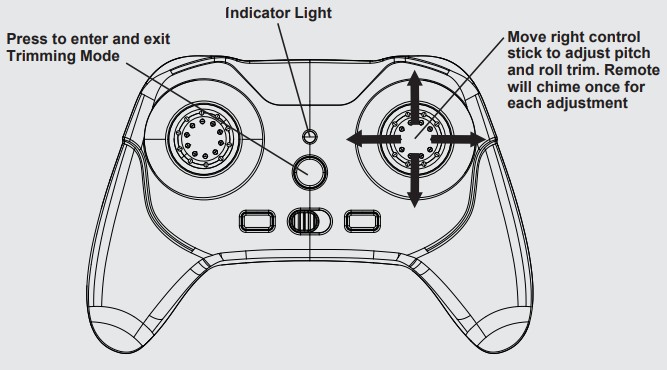
Gyroscope RecalibrationIf the drone is having difficulty flying or is behaving erratically, its gyroscopes may need to be recalibrated. Do not attempt to do this while flying. Safely land the drone first and place it on a flat surface.Note: The craft and the remote should already be linked together.Pull down and inwards on both control sticks for 2-3 seconds. When the LED lights have stopped blinking and turn solid, the recalibration is complete and the drone is ready to fly.
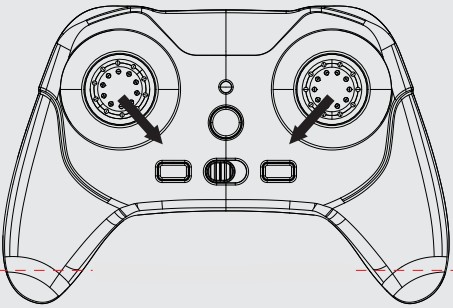
Tips for Safe Operation
- It is recommended to only fly in large, open spaces that are free of obstacles like power lines, trees, ceiling fans, etc
- When flying indoors, avoid walls and ceilings, as the drone may be drawn towards them if closer than 2-3 feet.
- Stand behind the drone when first taking off, so that you and the drone are facing the same “forward” direction. This will help with orientation when the drone is airborne.
- Novice pilots should move the controls slowly and deliberately to become accustomed to the drone’s flying characteristics. Try using one control at a time.
- Practice basic flight operations like takeoff, hovering, and landing.
- If you get into trouble or if anything obstructs the rotors, cut power immediately and safely clear the obstruction. Check for possible damagebefore flying again.
Parts and Repair
REMINDER: Pilots are responsible for any damage caused by improper use.
Rotors ReplacementThe drone comes with replacement rotors if the originals are broken or damaged.Use the included screwdriver to remove the rotor retaining screw that holds the rotor to the motor shaft. Once the retaining screw is out, pull upwards on the rotor to remove it from the motor shaft. Installation of the new rotors is the reverse of the removal process. Be sure to tighten the rotor retaining screw firmly, but do not overtighten.It is essential to use the correct rotors (A or B) for replacement.Using the incorrect rotors will make the craft impossible to control. The marking can be found on the rotor near the shaft.
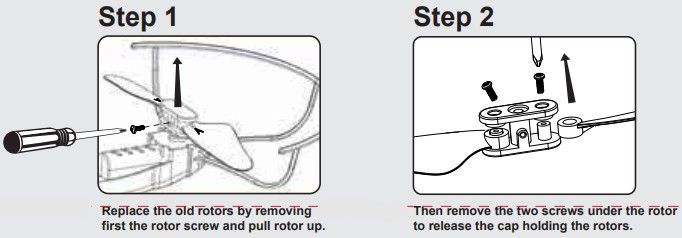

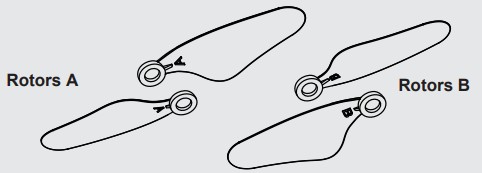
Cleaning InstructionTo clean, wipe excess dirt from the toy. Wipe toy clean with a damp cloth. Wipe dry.DO NOT IMMERSE IN WATER and DO NOT CLEAN VEHICLE WITH ANY CHEMICALS.Let the toy completely dry before playing.
Important:Follow this diagram to know the correct placement of the rotors A or B.
Incorrect placement of the rotors will cause the craft not to operate properly.
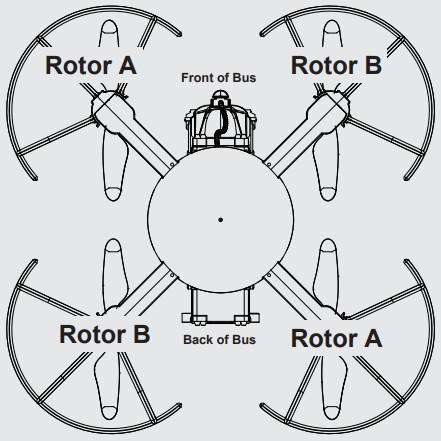
Troubleshooting Guide
| PROBLEM | POSSIBLE CAUSES | SOLUTION |
| The drone does not respond to controls |
|
|
| The drone is difficult to control or flies erratically |
|
|
| Drone drifts while in flight |
|
|
| Drone suffers frommechanical trouble |
|
|
| LED light ON but drone does not respond to controls |
|
|
 Used with permission. Manufactured and Distributed by:Jazwares, LLC, Sunrise, FL 33326, USAJazwares, 16A Crane Grove, London, N7 8LE, United Kingdom Jazwares GmbH, Mina-Rees-Str. 8, 64295 Darmstadt, Germanywww.jazwares.com / www.jazwares.de© 2019 Epic Games, Inc. Fortnite and its logo are registered trademarks of Epic Games, Inc. in the USA (Reg. U.S. Pat. & Tm. O.) and elsewhere.All rights reserved.
Used with permission. Manufactured and Distributed by:Jazwares, LLC, Sunrise, FL 33326, USAJazwares, 16A Crane Grove, London, N7 8LE, United Kingdom Jazwares GmbH, Mina-Rees-Str. 8, 64295 Darmstadt, Germanywww.jazwares.com / www.jazwares.de© 2019 Epic Games, Inc. Fortnite and its logo are registered trademarks of Epic Games, Inc. in the USA (Reg. U.S. Pat. & Tm. O.) and elsewhere.All rights reserved.
|
PROBLEMS? DO NOT RETURN TO THE STOREPlease Call Us: 1.800.370.1827(U.S. Customers Only) |
| IMPORTANT:Please save this instruction sheet.It contains valuable product information. |

Frequency band range: 2424-2453 MHzMaximum radio-frequency power: 0.05mW
The toy is only to be connected to class II equipment bearing the following symbol.Protect the environment by not disposing of this product with household waste (2012/19/EU).Check your local authority for recycling advice and facilities.The products can be sold in all EU countries.Frequency band range: 2424-2453 MHzMaximum radio-frequency power: 0.05mW
References
[xyz-ips snippet=”download-snippet”]

